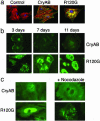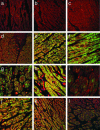Desmin-related cardiomyopathy in transgenic mice: a cardiac amyloidosis
- PMID: 15220483
- PMCID: PMC454177
- DOI: 10.1073/pnas.0401900101
Desmin-related cardiomyopathy in transgenic mice: a cardiac amyloidosis
Abstract
An R120G missense mutation in the small heat shock protein alpha-B-crystallin (CryAB(R120G)) causes desmin-related cardiomyopathy (DRM). DRM is characterized by the formation of aggregates containing CryAB and desmin, and it can be recapitulated in transgenic mice by cardiac-specific expression of the mutant protein. In this article, we show that expression of CryAB(R120G) leads to the formation of electron-dense bodies characteristic of the DRMs and identify these bodies as aggresomes, which are characteristic of the neurodegenerative diseases. Cardiomyocytes transfected with adenovirus containing CryAB(R120G) establish the necessity and sufficiency of CryAB(R120G) expression for aggresome formation. The commonality of these aggresomes with oligomeric protein aggregates found in the amyloid-related degenerative diseases was corroborated by the presence of high levels of amyloid oligomers that may represent a primary toxic species in the amyloid diseases. These oligomeric amyloid intermediates are present also in cardiomyocytes derived from many human dilated and hypertrophic cardiomyopathies.
Figures





References
-
- Adams, K. F., Jr. (2001) Am. J. Med. 110, Suppl. 7A, 6S-13S. - PubMed
-
- Lloyd-Jones, D. M., Larson, M. G., Leip, E. P., Beiser, A., D'Agostino, R. B., Kannel, W. B., Murabito, J. M., Vasan, R. S., Benjamin, E. J. & Levy, D. (2002) Circulation 106, 3068-3072. - PubMed
-
- Knoll, R., Hoshijima, M., Hoffman, H. M., Person, V., Lorenzen-Schmidt, I., Bang, M. L., Hayashi, T., Shiga, N., Yasukawa, H., Schaper, W., et al. (2002) Cell 111, 943-955. - PubMed
-
- Heling, A., Zimmermann, R., Kostin, S., Maeno, Y., Hein, S., Devaux, B., Bauer, E., Klovekorn, W. P., Schlepper, M., Schaper, W. & Schaper, J. (2000) Circ. Res. 86, 846-853. - PubMed
Publication types
MeSH terms
Substances
Grants and funding
LinkOut - more resources
Full Text Sources
Other Literature Sources
Medical
Molecular Biology Databases
Research Materials

